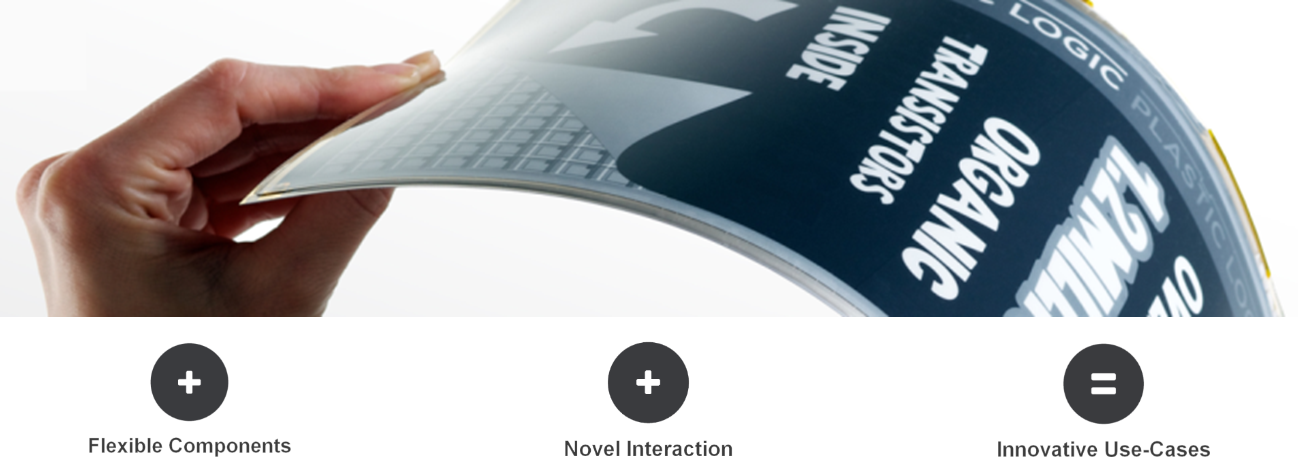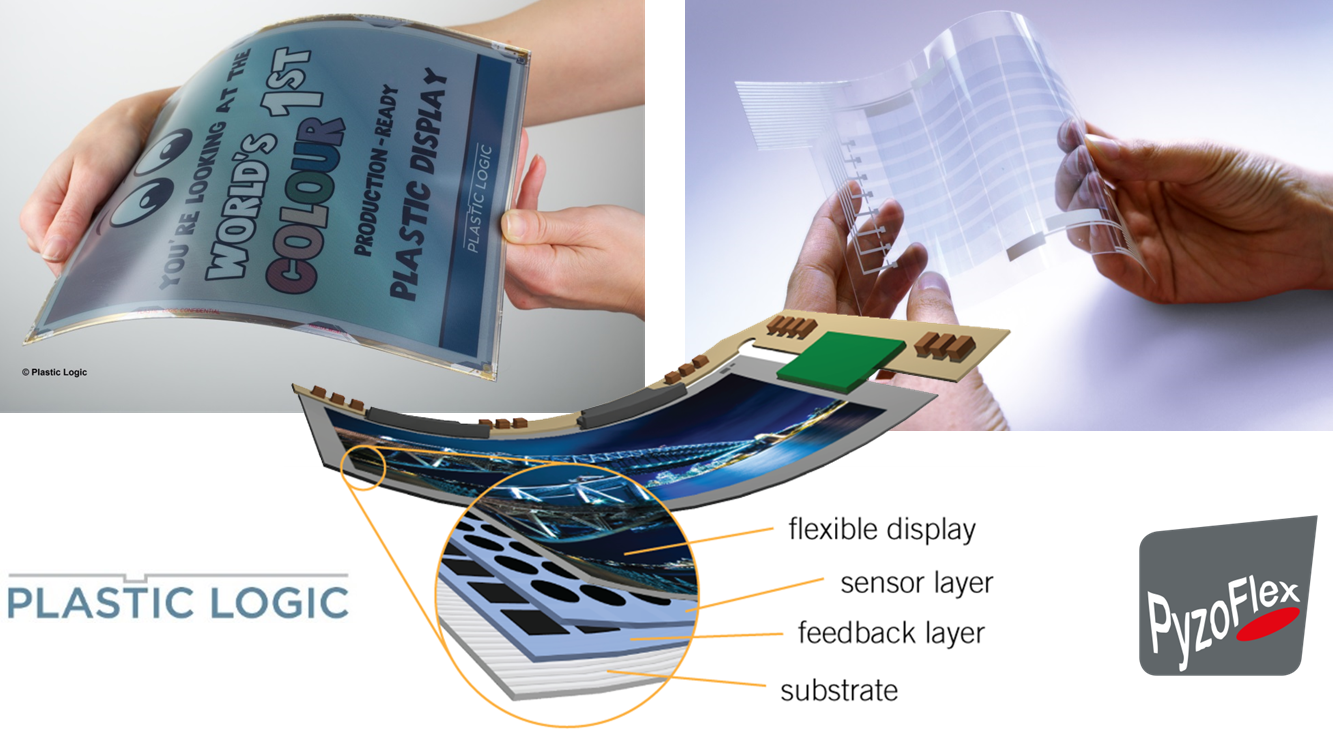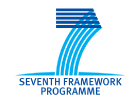FLASHED - Flexible Large Area Sensors for Highly Enhanced Displays
We have seen a large rise of novel and user-friendly interfaces that move beyond the paradigm of mouse and keyboard for input. Multi-touch screens are now the de-facto standard in mobile devices such as phones and tablets, depth cameras are increasingly being used to capture gestural input in the living room and beyond. This rise in adoption of such ‘natural’ user interfaces shows there is a great deal of user demand for simpler ways of navigating information and content, where the computer interface is not a barrier, but enables them to accomplish tasks more quickly and easily.
Arguably whilst the input between user and computer has become greatly enriched due to innovations in user sensing technologies such as touch and depth sensors, there has been less significant work that has explored novel output or display mechanisms coupled with this novel input. The project “Flexible Large Area Sensors for Highly Enhanced Displays” (FLASHED) will address this challenge of building a novel user interface device that couples novel input with output.

In FLASHED, we will discover a new technology in the field of flexible displays. A major problem of flexible displays is still the lack of interactivity, because none of the market-ready touch solutions are flexible (bendable). Therefore, one major goal of FLASHED is the development of novel, flexible touchscreen solutions, covering aspects like cost-effectiveness (all-printed), sustainability (material recycling and end-of-life disposal) and energy-efficiency (self-sustaining sensor arrays). Moreover, the FLASHED project puts strong emphasis on user-friendly interfaces. The FLASHED device itself consists of a flexible display, a touchscreen layer based on a pressure sensing touch array (utilizing ferroelectric polymers) and a haptic/acoustic feedback layer based on a relaxor ferrolectric material.
The R&D work starts with research into developing new ink-materials (ISC & JOR) for the touchscreen as well as the feedback actuator layer and with the development of the layers, of the microcontroller and of the software (JOR, FHOOE). Based on the input layer, we will integrate it with the output (feedback) layer and the flexible display (PLL) and implement demonstrators (FHOOE, PLL, MSR). Formative evaluation (FHOOE, MSR) combined with a two-round development process will ensure that the FLASHED results fit its users’ needs while summative evaluation will validate the overall utility of the approach to promote flexible interactive surfaces.


Integration of display, sensor and feedback layer.
Plastic Logic
Plastic Logic is the recognised leader in organic thin-film transistors (OTFT) and is at the forefront of research and investment in plastic electronics. The company has industrialised the process and now manufactures a range of high-quality flexible plastic displays. These shatterproof daylight readable displays are ultra-thin, ultra-lightweight and very low power, offering huge advantages over conventional screens as they are extremely flexible with proven lifetimes. Flexible displays enable revolutionary design possibilities and are set to transform existing markets, such as signage, wristwatches and other wearable devices, and automotive as well as many others. Plastic Logic is backed by major investors including Oak Investment Partners and Rusnano.
Media Interaction Lab, University of Applied Sciences Upper Austria
The Media Interaction Lab is the leading Austrian research lab in the area of Human-Computer Interaction. As part of the Department for Interactive Media of the University of Applied Sciences Upper Austria in Hagenberg, the Lab integrates research and education and provides students with a project-based learning environment. Both undergraduate, graduate and PhD students from our University and abroad carry out projects in the lab. Students can undertake projects in the lab as part of their studies or alternatively work in the lab as an extracurricular activity. Currently, the lab is working on a range of projects in collaboration with industry and academia. Over the past six years, the research group has mainly focused on exploring the potential of Interactive Environments as a medium for dramatic experience. The lab’s research has three main focuses: exploring novel interface technologies, developing new interaction techniques, and evaluating user interfaces. In FLASHED, the Media Interaction Lab will primarily develop the natural user interface based on the FLASHED technology. With the strong HCI experience, the lab will also support the project during the empirical research studies.
Fraunhofer Gesellschaft zur Förderung der angewandten Forschung e.V.
The Fraunhofer Gesellschaft zur Förderung der angewandten Forschung e. V. is the largest organisation for applied research in Europe. Research topics are amongst others “safety and security”, “information and communication”, or “environmentally friendly production”. The Fraunhofer Institute for Silicate Research located in Würzburg, Germany, is one of the most experienced institutes with respect to sol-gel materials and hybrid material concepts. It investigates and optimizes materials to provide new solutions for topics like: coatings for finishing, materials for energy storage and saving, smart materials, and materials used in the field of life science (diagnostics and therapeutic materials). The needs of the industrial customer form the guideline of the material development of Fraunhofer ISC taking into consideration the function, the processing and the scalability of the material as well as legally and economic aspects. <br/> For a decade, the institute has been developing materials for printed electronics, such as dielectrics and barrier materials, and, finally, for printed sensor applications. This expertise is used in the FLASHED project to create novel sensor concepts, touch screens and interface technologies. The knowledge is amplified by fruitful long-time co-operations with Joanneum Research, Austria, and other renowned research institutes and technology driven companies.
JOANNEUM RESEARCH is a professional innovation and technology provider with a track record of 30 years in cutting-edge research at international level. It focuses on applied research and technology development, thus playing a key role in technology and knowledge transfer in Styria. JOANNEUM RESEARCH actively cooperates with the business and public sectors to generate new innovations and carries out application-oriented research and development projects to promote technology transfer to industry. It´s strengthens its activities as a professional innovation and technology provider with a focus on applied research and technology development.
Microsoft Research is one of the leading research organizations in the world. The research lab in Cambridge in UK was established over 15 years ago and brings research expertise into novel sensors, signal and image processing algorithms and human computer interaction. The Interactive 3D technologies (I3D) group and the Computer Vision group, the two groups that will be engaged within the FLASHED project, have already been responsible for projects such as the Kinect body tracking algorithms, the Microsoft Touch Mouse (a mouse with a curved multi-touch sensor), the Microsoft Surface and the Sensor-in-Pixel touch display. This level of expertise ranges from the underlying hardware design through to the user experience.

